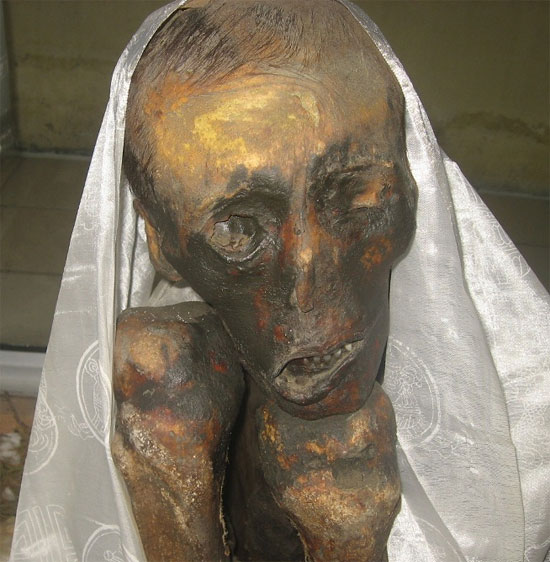The 500-year-old Zen master remains intact with teeth and hair in India
This 500-year-old mummy is the Zen master Sangha Tenzin. This is one of the artifacts found by scientists in Key Gompa monastery (or Ki, Kye, Kee) in the Spiti valley, located between India and Tibet in 1975.
According to archaeologists, it is the oldest and largest monastery in the Spiti valley of Himachal Pradesh. This is also a cradle to train monks and there are about 300 lamas who practice at the monastery.
After finding the mummy intact with the dry skin, the hair remains intact on the head, the teeth and nails are still full . the scientists have made the hypotheses about how to embalm the mystery of the meditation this monk.
Some people hypothesize that Zen master Sangha Tenzin has undergone a rare process of natural embalming or self-embalming.
Natural mummification is a very rare case. It requires meeting extreme conditions such as high temperatures and dry air to protect the body. Most mummies that humans see (in textbooks and museums) undergo a chemical mummification process and are then wrapped in linen.
But Buddhist practitioners in Japan and Tibet have a unique method to embalm. That's when monks are alive, they start a process of eating less and the menu is also more frugal than before. They do not continue to eat barley, rice and beans because these things increase body fat. In addition, to prepare for the day of the record, the monk used burning candles near his skin to dry them. Through that special method, the monk's body is better preserved.

The mummy of a 500-year-old Zen master was excavated in 1975. (Photo: Bcmtouring.com)
The embalming work did not stop there, the living monks would place the Zen master in an underground room for 3 years as well as continue drying the skeleton before going through the last stage. Use candles to have "perfect" mummies. As a result, the monk's body has the shape of temple statues used to pray.
Scientists found at least 30 mummies of monks in the world, most of them in large Japanese islands, Honshu applying this method.
Meanwhile, Western researchers relied on skeletal analyzes to suggest that the meditator might have taken a special toxin, so that the bacteria did not grow, causing the body to shrink and turned into a mummy.
Another hypothesis given by scientists is that in the last months before he passed away, the Zen master Sangha Tenzin did not eat or drink. This will reduce the amount of fat and meat in the monk's body. This is the cause of decay and decomposition in mummies.
Since then, the parts of the Zen master's body will gradually become dry and dry. Not stopping there, the Zen master even wrapped himself in his neck, connected to his thighs and hands before he died. When the meditation teacher passed away, the rope kept this Buddhist monk's body intact in a sitting posture.
However, some researchers hypothesized that Zen master Sangha Tenzin used a method of meditation that few people knew could keep his mummy so good. According to this explanation, the Zen master forced himself a rope early. It is the task of keeping the monk sitting upright, straight and meditating with the highest concentration, without being dispersed by external influences. If the Zen master loosens his body, the knot around the neck will tighten, making it difficult for him to breathe.
In addition, the environment has a great impact on the body of the Zen master. Because, the dry environment makes bacteria have less chance to grow, proliferate so the mummy is preserved in a completely natural way.
The 500-year-old mummy of Zen master Sangha Tenzin is displayed at a temple in Gue, about 3.2 km from the Spiti valley area. The open temple welcomes visitors to admire and learn about this special mummy.
- Found the remains of ancient people 3,500 years ago
- The 125 million-year fossil remains intact, the hair of prehistoric mice
- 47-year-old teacher died after 10 days of dyeing her hair
- Hair fibers are expected to make history after 500 years Leonardo da Vinci died
- The remains of a thousand year old skin remain intact after the storm in Ireland
- The mystery of the corpse after 23 years remains intact
- Mongolian warrior has blond hair
- Braided hair may belong to the goddess in the coffin
- Detecting intact 6,000-year-old skeleton under construction site
- Touched with the fasted dog on the grave
- Why do 7-year-olds have 526 teeth?
- The bird buried under the ice for 4,000 years remains intact
 'Fine laughs' - Scary and painful torture in ancient times
'Fine laughs' - Scary and painful torture in ancient times The sequence of numbers 142857 of the Egyptian pyramids is known as the strangest number in the world - Why?
The sequence of numbers 142857 of the Egyptian pyramids is known as the strangest number in the world - Why? History of the iron
History of the iron What is alum?
What is alum?